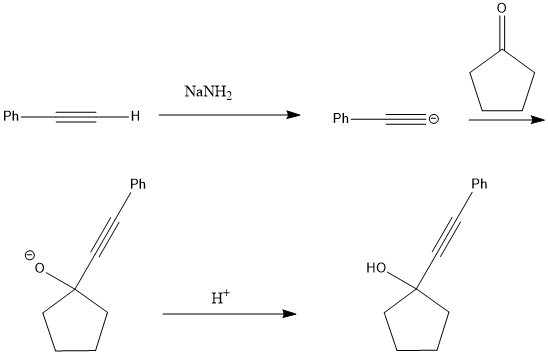 From my notes $\ce{NaNH_2}$ is a good base for the deprotonation of alkynes. After the deprotonation I thought the alkyne would attack the carbon on the cyclopentanone because of the $\delta^+$ charge on the carbonyl carbon due to the EWG effects of the oxygen. Should the protonation of the $\ce{O^-}$ be carried out with conditions specified or can I just leave it as the addition of $\ce{H^+}$?
From my notes $\ce{NaNH_2}$ is a good base for the deprotonation of alkynes. After the deprotonation I thought the alkyne would attack the carbon on the cyclopentanone because of the $\delta^+$ charge on the carbonyl carbon due to the EWG effects of the oxygen. Should the protonation of the $\ce{O^-}$ be carried out with conditions specified or can I just leave it as the addition of $\ce{H^+}$?
-
$\begingroup$ There is no such compound as $\ce{NaNH3}$. It is easy to mix up sodium in liquid ammonia $\ce{Na}/\ce{NH3}$ with sodium amide $\ce{NaNH2}$. Make sure you know what you are writing. As for the final workup, you definitely need some kind of proton source. $\endgroup$– orthocresolCommented Dec 10, 2015 at 17:04
-
$\begingroup$ Thank you i must have taken that down incorrectly, ok so would $H_3O^+$ suffice? @orthocresol $\endgroup$– MrLuke370Commented Dec 10, 2015 at 17:20
-
$\begingroup$ Again, please make sure you know what you are writing. If you treat the alkyne with $\ce{Na}/\ce{NH3}$, you are going to get a trans alkene, not the acetylide ion. For the final workup, it depends on how strict your marking scheme is, but I would recommend you write an actual compound like water. You can't go out and buy a bottle of "$\ce{H3O+}$" from Sigma-Aldrich. $\endgroup$– orthocresolCommented Dec 10, 2015 at 17:21
-
$\begingroup$ Ok so would the conjugate acid of the sodium amide protonate the $O^-$? @orthocresol $\endgroup$– MrLuke370Commented Dec 10, 2015 at 17:24
-
$\begingroup$ Or would that be too weak an acid to do so? $\endgroup$– MrLuke370Commented Dec 10, 2015 at 17:43
2 Answers
The route definitely looks feasible and it is more or less what I would have done to arrive at your desired product. A few notes:
Make sure you actually have sodium amide $\ce{NaNH2}$ and not sodium in ammonia $\ce{Na/NH3}$. As pointed out in the question comments, they react very differently; the latter generates a trans-alkene.
I’m not sure I would have chosen the same base. But the choice of base is likely arbitrary anyway. n-Butyllithium would definitely also do the trick but might be overkill.
Typically in a lab setting, reactions with strong bases (as is the case here) are carefully quenched with something aquaeous. So you can be sure that there will be an aquaeous proton source ($\ce{H2O}$ or $\ce{H+/H2O}$, depending on your markers’ preferences) in the end. There should be no need to additionally specify conditions. It would make no sense to attempt to isolate the alcoholate anyway.
The reaction looks OK to me, but I would like to point a few things out. When I was in Aberdeen I used to do a lot of alkylation chemistry in liquid ammonia.
I have always found that the reaction of sodium metal with ammonia to make sodium amide is a mighty pain. I have always found that the reaction is very sluggish at first and then it suddenly takes off and generates a lot of heat which then greatly increases the boiling rate of the ammonia.
I found in Scotland that potassium metal reacts with ammonia nice and gently if you put a little of an iron salt into the liquid ammonia. The first time I did it the reaction put the fear of God in me. But I found that it is easier and safer to use potassium to make potassium amide than to make sodium amide.
I would suggest that you should make sure that all of the solvated electrons have reacted before you add the alkyne (acetylene). The solvated electrons are an inky blue. It is interesting that solvated electrons form if you either dissolve sodium in water or bombard it with high energy electrons or gamma rays. In water the rate of the reaction of solvated electrons with solvated protons to form hydrogen atoms and water is far faster than the rate of reaction of solvated electrons in liquid ammonia with the ammonia to form hydrogen atoms.
Maybe after some years of doing things with atoms you will start to see everything through the lens of nuclear chemistry.
But back to the organic chemistry, I would make the slurry of potassium amide in liquid ammonia and then cool the mixture to -78 oC with a dry ice / acetone bath. Then I would slowly drip in an ether solution of the phenyl acetylene. I would allow it to react for a while and then slowly add the ketone. I would leave it stirring at -78 oC for a while and then the quench I would use would be ammonium chloride powder. You just add the NH4Cl and then allow the mixture to slowly warm up.
The next day I would add ether to the reaction pot, if you then filter off the solids (KCl + NH4Cl) then you will have a solution of the product. I would be careful with the distillation as I recall that this sort of compound can be a bit acid sensitive. I think that vacuum distillation will be the best way to make it nice and pure.
